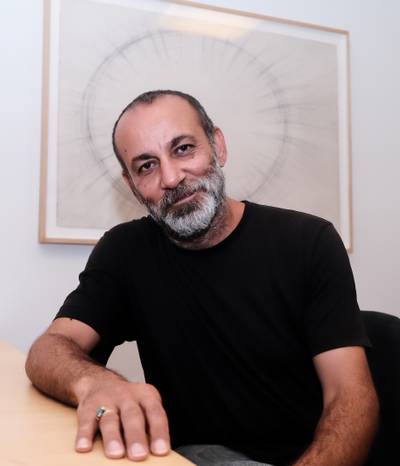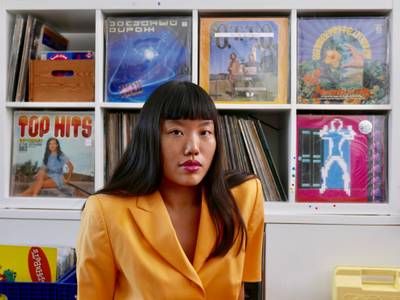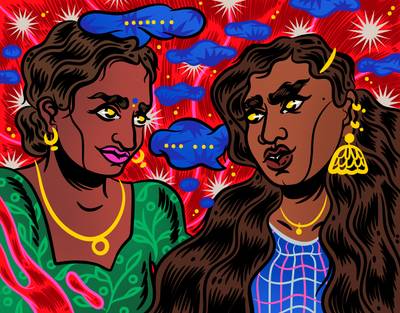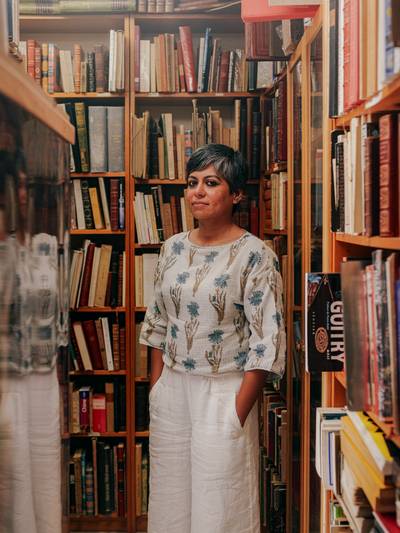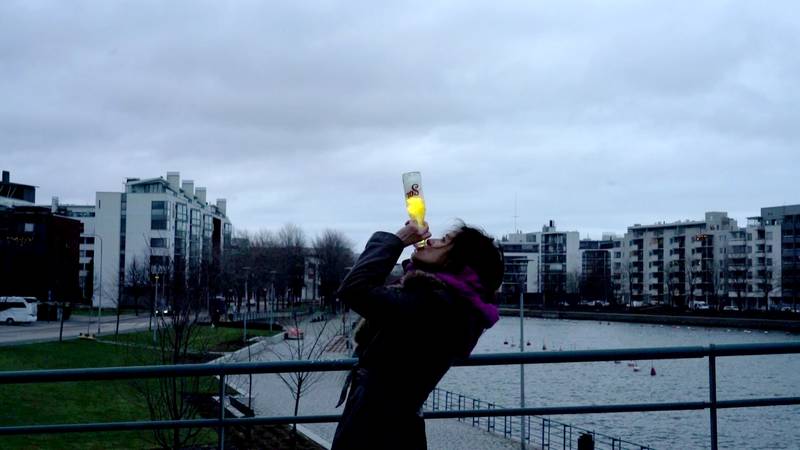

Video still from ‘Sol (from the series Seasonal Hobbies)’, 2019
Lois Armas is a Helsinki-based author and oral historian. Her debut novel, Flora, was published in 2023 by WSOY Publishing House. She is currently working on her second novel. Her writing interests focus on parent-child relationships, family dynamics, and loneliness. She works for a film festival and runs a community-building writing project, JA, which offers printed visibility and a safe space for writing to beginner writers. She loves journaling, reading, and answering her 4-year-old’s questions.
Diana Soria Hernandez is a visual and performance artist based in Helsinki since 2011. As I immersed myself in her extensive body of work, I became increasingly fascinated by the intimate spaces she creates in her performances. I was particularly intrigued by the relationship between Soria Hernandez and her audience. Does she aim for them to feel or understand something specific? Does that wish even matter? My questions delved organically into a deeper perspective: her artistic growth over the years. The following is a translation of two conversations we had in Spanish.
LOIS: In 2012, during the Saari Residence, you performed Flowers for Our Dead. For this piece, you had two cross-shaped stamps made. You invited two classmates to stamp 60,000 crosses on your skin to symbolise the estimated 60,000 deaths that occurred during Felipe Calderón’s government in Mexico. In the recording of the performance, the two participants stamped the crosses while counting aloud. Looking at the video, I felt as if your body was meant to absorb those deaths. What moved you to harness your body as an artistic tool?
DIANA: That was my first performance, and I did not even conceive of it as such. I was referencing a specific protest placard that reads, ‘These are not numbers, these are lives`, referring to what was framed as collateral damages from the war on drugs, becoming mere statistics. I chose to embody the slogan and use my classmates’ white European physiognomy to read out loud other banner sentences as privileged voices that had more chances to be heard than mine. Ever since, I have worked on several occasions with texts from banners because they are collective, precise and strong. Nevertheless, when socio-political slogans are repeated, their meaning is exhausted. I have been interested in trying to see how a banner text can reclaim its meaning when transferred to performance.
This bodily element implies strong intimacy during the performance. Do you aim to create a space of vulnerability between you and the audience?
Performance art, for me, can be the most vulnerable of art forms. Although some performances are hyper-produced, with a team and a budget behind them, mine depart from a sketch or a plan that is adjusted live to the situation and context. This is what interests me: the openness that makes a performance alive, which can work as a window to allow things to happen
Performance art is also the only art form I can think of that allows itself, while being created on the spot, to ask for help, not as part of the script or in a manipulative way (which also happens) but as a way of solving the piece, creating a bond with the audience.
When you rely on help given by the audience, there is always a certain degree of risk in how they will react and how this will affect the development of the piece. I think who we are and how we ask in these moments is crucial since there is often a big imbalance in the artist/audience relationship—rarely is the audience empowered. They easily yield to the artist’s requests. So when I put myself in a position of vulnerability, as you say, a shift may occur in them. They can choose to approach the piece differently. At the same time, there is a complement to this vulnerability, and that is the awareness and strength required from the performance artist to retain control of the piece. It is necessary to find this balance: what is in my control and what remains open—and hold that space throughout the piece.
Your early works are more explicitly political than your most recent pieces. The Ayotzinapa performances from 2014 to 2016 are particularly meaningful. They deal with an event in Mexico that took place in 2014: the disappearance (and, in some cases, confirmed murder) of 43 rural students. The series of performances was a loud call against official, manipulated versions of what had happened. You performed in public spaces and festivals with a network of collaborators: activists and academics. What was the effect of geography and privilege in this case? Could the audience even connect with the performances and the issues they addressed?
First of all, back then, I was pursuing an MA in Live Art and Performance Studies at Teatterikorkeakoulu, and I conceived these performances as a reaction to urgency, a way of testing performance as a tool for social change beyond art values. I was aware of the humanitarian crisis taking place back in Mexico, and I questioned myself about how I could contribute to the social movements from a privileged position of being in Finland. In my studies, I had a difficult time dealing with questions regarding what impunity or necropolitics can look like. I explored the notion of artivism and whether it could fit within my work. I read and researched artists I deeply admire, such as Guatemalan performance artist Regina José Galindo, who, although often mentioned as an example of an artivist, rejects this label. Aware of the political context of countries like Mexico, where activists are murdered for the work they do, it would be insulting to call myself an artivist. These are precisely part of the changes I have gone through: to explore concepts, to use them even, and eventually come to the realisation that they do not define my artistic processes.
Did it matter if the Finnish audience got it? I was performing in Finland but relying on documentation, hoping that my work could sum up the loud uproar for justice. It was a global movement.
These series of performances were very instrumental in my artistic growth. I realised while making Ayotzinapa how fundamental it is to communicate with the audience: the way I tell things, the way I can reach the affects of the audience —as a result, I started working with elements and topics that appeared to be lighter and easier to digest, but that was an exploration of Finnish affects.
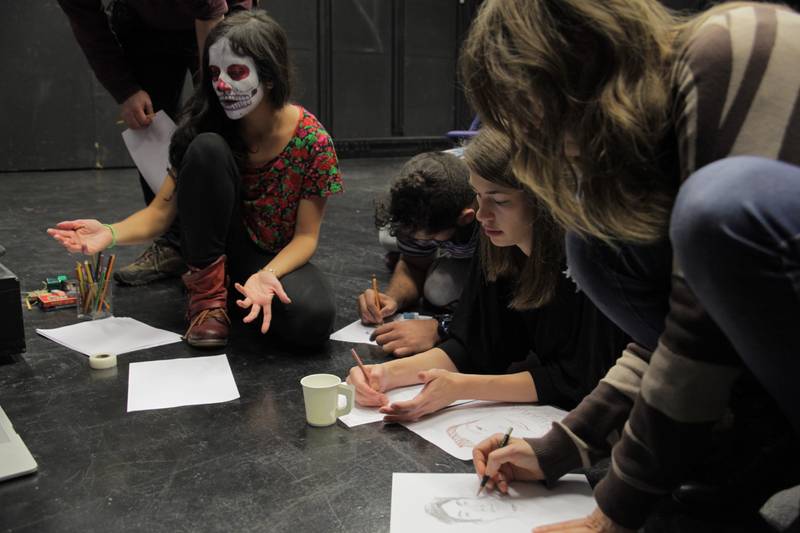

‘Ayotzinapa 01’, 2014 | Photo: Jakob Johannse
When you say lighter, do you mean ‘less raw’?
Yes, less raw. Coming from Latin America, we are used to explicit violence, images, and language; and after the Ayotzinapa performances, I understood that I had to find the gaps into their affects to reach them with the topics that are important to me. So I began exploring an almost poetic performance art form, based mainly in natural elements and that at the same time gave me space to play and build connections to those cultural elements that don’t have a place in my affects: nature, for example. This ongoing series went by the name of Seasonal Hobbies, and I suspect, in Mexico, it could be read as shallow.
My work Wanna Be Tuohi (2017) is an example of this playfulness and lightness. I have often worked with tuohi (birch bark), and I address it directly to my Finnish audience; for a Mexican audience, it would not hold any meaning. But here I am interested in the question: what would someone here, in Finland, read and see while looking at it?
Right now, think of myself as a Finnish performance artist and a Mexican visual artist. It does not mean I identify with a state but rather with certain visual languages, artistic traditions, and ways of understanding and using the body. The series Seasonal Hobbies are lighter or even humorous and are connected with a Finnish tradition of performing that falls within certain cultural guidelines: performance in Finland is not as political as in Latin America. It is then a matter of finding the in-between because neither works in its entirety; both are heavy in a sense: Latin American performance art can be too explicit, and Finnish performance art often portrays the immaterial.
As you talked before about the direct interaction between you and the audience, I want to go back to that. What is your ultimate wish when it comes to the audience? Is it that they understand your performances?
If the goal is to understand, then we might as well write essays. Rationality has historically had a hegemonic place in the West: what we see has to be comprehended. The ultimate goal is to create a message and transmit it in a way that people can understand.
But performance is a space for something else. I am interested in what can turn around words and enter through different senses without a rational filter. I believe we have less protection for gestures and less digestive capacity for actions. In that way, performance can creep into the audience through the rational walls, perhaps affecting the spectator in other ways.
When crafting a performance, I choose certain elements that are important to me, and I interconnect them, aware of their materiality, temporality and symbolism: that is their language. My initial performances had a clear political undertone and a sense of urgency. I did want to be fully understood, but I was in a geopolitical context where that was impossible. People expected factual explanations about the events I was delving into: when, how, where, and why. Yet, upon obtaining the data in question—like in the Ayotzinapa performances—an emotional detachment would take place in the audience. They would become distant and indifferent. At the end of my studies, after many attempts and failures, I understood that I was not interested in being a performance artist messenger but rather in the potential of performance that escaped the linear, digestible narratives.
There is always a desire for communication, of course. As I said, it is not a literal desire but a wish to play with the performance elements and discover what can come out of it. I find this extremely interesting. To place elements together and see what can happen. Someone in the audience can perhaps read a symbol very well, but if I then introduce another element from another context, a glitch is most likely to be generated. There lies the potential of the performance in that unknown moment. Not because you are learning something new but because you are feeling something you do not understand. I feel that the exploration of that space is fundamental.
Throughout the years, there have been elements that have remained constant in your art: the use of your body as a communication tool, the intimacy you create, and certain objects such as hair dryers or balloons. You also talk about how your ways of communicating have changed when performing. I would like to know, what else has changed? What do you explore nowadays?
As my stay in Finland veered towards permanence, the country’s mystique faded. Coming from a place where culture is overly charged with symbolism, I started looking for comparable symbolism here. There are a few elements, simple ones to which my Finnish audience could relate falling into nationalist appreciation—think of Marimekko, for example. Nowadays, my interest lies in exploring them. And this is a significant change because I would have wanted to dress up in these symbols to belong. Now, what I want is their exploration and their questioning.
Devil’s Flowers (2021) is a performance I had thought about for a while. It involves poppy flowers, iconic of Marimekko, but also an element linked to opium cultivation in Mexico. I wanted to show how relating to a poppy flower in one way or another depends on one’s privilege. If I’d shown this performance anywhere else, it would’ve had no meaning. It has a specific meaning in these two places, Mexico and Finland. It unites two geographies, which is very different from my first performances about Ayotzinapa.
Coming back to the questions: Who is the viewer? Who is on the other side? I also engage in critical questioning. One of the works I exhibited in my latest exhibition, Where do I go from here? At the MUU Helsinki Contemporary Art Center is called Token (2022). This piece consists of a one-minute video where, one by one, I chew different lipsticks. With each lipstick, I repeat “identity” as I mix them in the cavity of my mouth. The molten lipstick gushes out and slathers my face. Token was born from the frustration of being constantly invited to events to fill a quota. It is so depressing; it stuns you. But I refuse to relinquish spaces that are mine. So I take up these opportunities while finding myself in a complex situation: feeling used while occupying what’s mine. It is an ugly negotiation that becomes especially dirty when you realise that other artists do not have to navigate it: they feel valued.


‘Flores para nuestros muertos (Flowers for our dead)’, 2012, Saari Residence, Mynämäki, Finland, with the assistance of Riku Mäkinen, Samppa Törmälehto and Johannes Heikkilä | Photo: Karl Ceder
